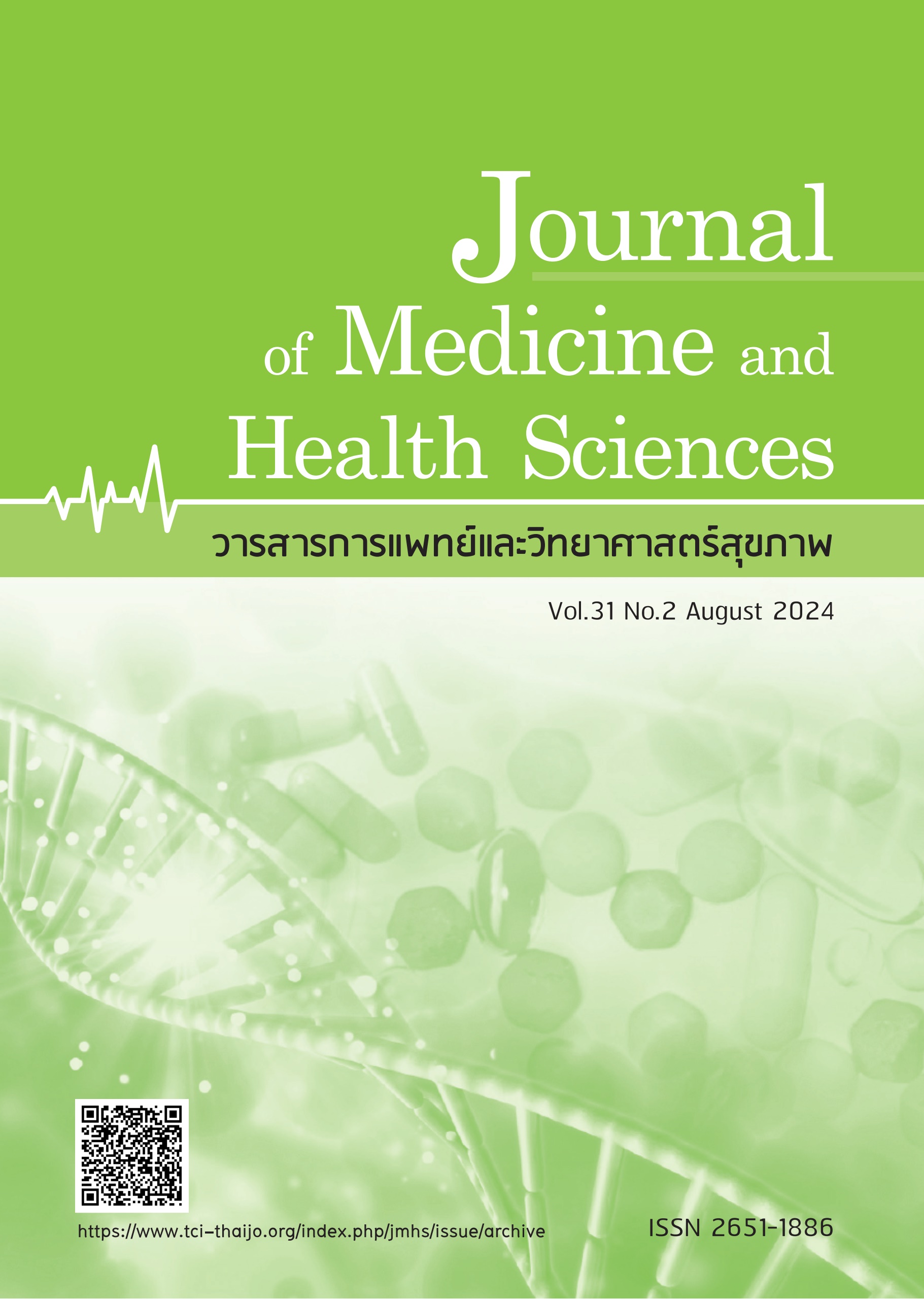การวัดปริมาณรังสีจากผู้ป่วยในแต่ละการตรวจวินิจฉัยทางเวชศาสตร์นิวเคลียร์และในผู้ปฏิบัติงานทางการแพทย์
คำสำคัญ:
เวชศาสตร์นิวเคลียร์, อัตราการแผ่รังสี, เพทซีทีสแกนบทคัดย่อ
การตรวจเวชศาสตร์นิวเคลียร์มีการให้สารรังสีเข้าไปในร่างกายผู้ป่วยเพื่อแสดงข้อมูลการทำงานของอวัยวะและพยาธิวิทยา ซึ่งทำให้เกิดข้อกังวลถึงความปลอดภัยทางรังสีเมื่อต้องปฏิบัติใกล้ชิดหรือการดูแลผู้ป่วยที่ได้รับสารรังสี การศึกษานี้มีวัตถุประสงค์เพื่อตรวจวัดอัตราการแผ่รังสีจากผู้ป่วยในแต่ละการตรวจวินิจฉัยทางเวชศาสตร์นิวเคลียร์ โดยการใช้เครื่องสำรวจรังสีชนิดบรรจุก๊าซตรวจวัดอัตราการแผ่รังสีจากผู้ป่วย จำนวน 3 ครั้ง หลังฉีดสารเภสัชรังสีทันที ขณะทำการตรวจวินิจฉัยทางเวชศาสตร์นิวเคลียร์ และก่อนผู้ป่วยกลับบ้าน ในการวัดแต่ละครั้งจะวัดอัตราปริมาณรังสีที่ระยะ 0, 0.25, 0.5, 1 และระยะ 2 เมตร ผลการศึกษา การวัดค่าอัตราการแผ่รังสีจากผู้ป่วย จำนวน 385 คน เข้ารับการตรวจทางเวชศาสตร์นิวเคลียร์ จำนวน 21 รายการ พบว่า การตรวจที่มีค่าอัตราการแผ่รังสีเฉลี่ยสูงกว่า 10 µSv/hr ที่ระยะ 0 เมตร หลังผู้ป่วยได้รับรังสีสารเภสัชรังสีทันที จากการตรวจ 6 ประเภท ในขณะตรวจทางเวชศาสตร์นิวเคลียร์ มี 5 ประเภท และก่อนผู้ป่วยกลับบ้าน พบในการตรวจ 2 ประเภท โดยการตรวจ PET/CT scan มีอัตราการแผ่รังสีสูงสุด เท่ากับ 248 µSv/hr เมื่อวัดค่าทันทีหลังฉีดสารเภสัชรังสี และลดลงเมื่อวัดค่าขณะตรวจ และก่อนผู้ป่วยกลับบ้าน โดยอัตราการแผ่รังสีลดลงเมื่อระยะเพิ่มมากขึ้น สำหรับค่าอัตราการแผ่รังสีที่วัดค่าก่อนผู้ป่วยกลับบ้าน ไม่พบว่ามีการตรวจใดที่มีอัตราการแผ่จากตัวผู้ป่วยเกิน 50 µSv/hr ที่ระยะ 1 เมตร สรุป อัตราการแผ่รังสีจากผู้ป่วยในการตรวจวินิจฉัยทางเวชศาสตร์นิวเคลียร์ เมื่อวัดค่าหลังฉีดสารเภสัชรังสีทันที ขณะทำการตรวจวินิจฉัยทางเวชศาสตร์นิวเคลียร์ และก่อนกลับบ้าน มีค่าอยู่ในเกณฑ์ปลอดภัยทั้งผู้ปฏิบัติงานและผู้ป่วย
เอกสารอ้างอิง
International Commission on Radiological Protection. ICRP Statement on Tissue Reactions / Early and Late Effects of Radiation in Normal Tissues and Organs – Threshold Doses for Tissue Reactions in a Radiation Protection Context. ICRP Publication 118 Ann ICRP 41(1/2). 2012.
Wisetnan C, Awikunprasert P, Kaewsombat T, Molee P. Radiation emitted from patients undergoing nuclear medicine examination at Udonthani Cancer Hospital. J Assoc Med Sci 2021;54(3):73-7.
Willegaignon J, Fernandes SCP, Pelissoni RA, Coura-Filho GB, Sapienza MT, Buchpiguel CA. Radiation safety measures in diagnostic nuclear medicine, based on the potential radiation dose emitted by radioactive patients. Radiol Bras 2023;56(1):13-20.
Gomez-Palacios M, Terrón JA, Domínguez P, Vera DR, Osuna RF. Radiation doses in the surroundings of patients undergoing nuclear medicine diagnostic studies. Health Phys 2005;89(2 Suppl):S27-34.
Matusiak K, Wolna J, Jung A, Sadowski L, Pawlus J. Impact of the Frequency and Type of Procedures Performed in Nuclear Medicine Units on the Expected Radiological Hazard. Int J Environ Res Public Health 2023;20(6).
Bayram T, Yilmaz AH, Demir M, Sonmez B. Radiation dose to technologists per nuclear medicine examination and estimation of annual dose. J Nucl Med Technol 2011;39(1):55-9.
Nassef MH, Kinsara AA. Occupational Radiation Dose for Medical Workers at a University Hospital. JTUSCI 2017;11(6):1259-66.
Díaz Barreto M, López Bejerano GM, Varela Corona C, Fleitas Estévez I. On the safety of persons accompanying nuclear medicine patients. Radiat Prot Dosimetry 2012;152(4):313-6.
Elshami W, Erdemir RU, Abuzaid MM, Cavli B, Issa B, Tekin HO. Occupational radiation dose assessment for nuclear medicine workers in Turkey: A comprehensive investigation. J King Saud Univ Sci 2022;34(4):102005.
Poonak K, Uaratanawong S. Radiation dose to nurses per nuclear medicine examination. The Thai Journal of Radiological Technology 2018;43(1):44-7. [in Thai]
Pavičar B, Davidović J, Petrović B, Vuleta G, Trivić S, Šajinović V, et al. Nuclear medicine staff exposure to ionising radiation in (18)F-FDG PET/CT practice: a preliminary retrospective study. Arh Hig Rada Toksikol 2021;72(3):216-24.
Buapoon P. Nurses care for thyroid cancer patients receiving high doses of radioiodine-131. Journal of Siriaj Radiology 2015;2(2):110-22.
Takahashi Y, Hosokawa S, Tsujiguchi T, Monzen S, Kanzaki T, Shirakawa K, et al. Time-related study on external exposure dose of 2-deoxy-2-[F-18]fluoro-D-glucose PET for workers' safety. Radiol Phys Technol 2020;13(1):98-103.
Kheruka SC, Shankar N, Ora M, Gambhir S. Do Current Radiation Safety Guidelines allow the Safe Release of a Thyroid Cancer Patient after High-dose Radioiodine Therapy? An Indian Perspective. Indian J Nucl Med 2021;36(2):148-52.
Krajewska G, Krajewski P. Evaluation of internal exposure of nuclear medicine staff working with radioiodine in Poland. Int J Occup Med Environ Health 2023;36(5):587-95.
ดาวน์โหลด
เผยแพร่แล้ว
รูปแบบการอ้างอิง
ฉบับ
ประเภทบทความ
สัญญาอนุญาต
ลิขสิทธิ์ (c) 2024 วารสารการแพทย์และวิทยาศาสตร์สุขภาพ

อนุญาตภายใต้เงื่อนไข Creative Commons Attribution-NonCommercial-NoDerivatives 4.0 International License.



